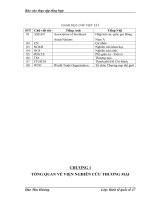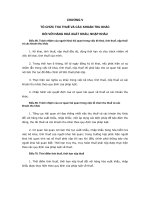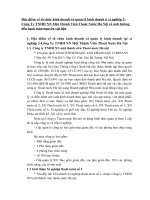Chương 7 Tổ chức kinh doanh và hành vi pps
Bạn đang xem bản rút gọn của tài liệu. Xem và tải ngay bản đầy đủ của tài liệu tại đây (92.88 KB, 10 trang )
Chapter 7
Business organization and behaviour
David Begg, Stanley Fischer and Rudiger Dornbusch, Economics,
6th Edition, McGraw-Hill, 2000
Power Point presentation by Peter Smith
7.2
The theory of supply
Costs of
production
Revenues
Firms’ decisions about how much output to supply
depend upon the costs of production and the revenue
they receive from selling the output.
Firm chooses
level of
output
7.3
Forms of business organization
■
Sole trader
–
owned by an individual entitled to income and
responsible for losses
■
Partnership
–
jointly owned by two or more people
–
unlimited liability
■
Company
–
ownership divided among shareholders
–
legal entitlement to produce and trade
–
limited liability
–
shares of public companies resold on the stock
exchange
7.4
Some key terms
■
Revenues
–
the amount a firm earns by selling goods
and services in a given period
■
Costs
–
the expenses incurred in producing
goods and services during the period
■
Profits
–
the excess of revenues over costs
7.5
A firm’s balance sheet
■
Assets
–
what the firm owns
■
Liabilities
–
what the firm owes
■
Balance sheet
–
lists a firm’s assets and liabilities at a
point in time
7.6
Snark International balance sheet
31 December 2000
ASSETS LIABILITIES
Cash
Accounts receivable
Inventories
Factory building
(original value £250,000)
Other equipment
(original value £300,000)
£ 40,000
70,000
100,000
200,000
180,000
£ 590,000
========
Accounts payable
Salaries payable
Mortgage from insurance
company
Bank loan
Net worth
£ 90,000
50,000
150,000
60,000
_______
350,000
240,000
£ 590,000
=======
7.7
Costs and the economist
■
Accounting cost
–
actual payments made by a firm in a period
■
Opportunity cost
–
amount lost by not using a resource in its
best alternative use
■
Supernormal profit
–
profit over and above the return earned at
the market rate of interest
■
Economists include opportunity cost in
a firm’s total costs
7.8
The production decision
■
For any output level, the firm attempts to
mimimize costs
■
Assume the firm aims to maximize profits
■
Profits depend on both COSTS and REVENUE
–
each of which varies with the level of output
■
Marginal cost (MC) is the rise in total cost if
output increases by 1 unit.
■
Marginal revenue (MR) is the rise in total
revenue if output increases by 1 unit
7.9
Maximizing profits
Output
Q
1
E
MC, MR
MC
MR
0
If MR > MC, an increase
in output will increase
profits.
If MR < MC, a decrease
in output will increase
profits.
So profits are maximized
when MR = MC at Q
1
(so long as the firm
covers variable costs)
7.10
Will firms try to maximize profits?
■
Large firms are not run by their owners
–
there is separation of ownership and control
■
Managers may pursue different objectives
–
e.g. size, growth
■
But firms not maximizing profits may be
vulnerable to takeover
–
or managers may be given share options to
influence their incentive to maximize profits









